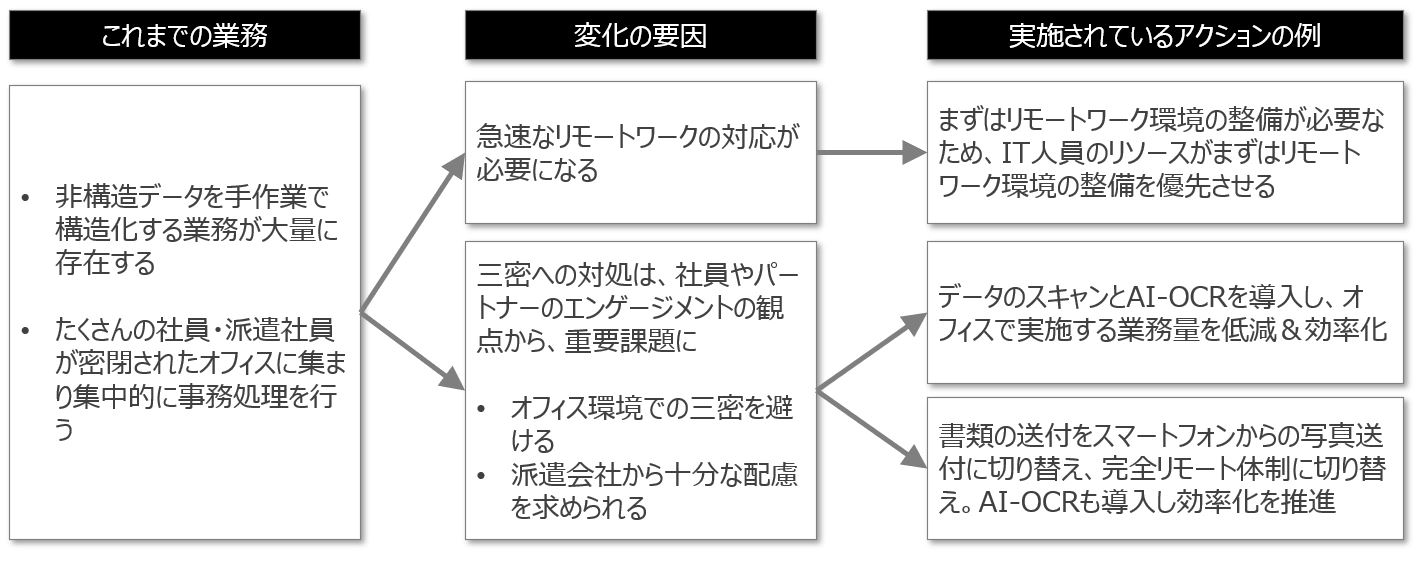
blog cinnamon blog

- management
<第3回>With the changing work style and AI utilization in the corona era
Learn from specific examples of work styles that change in office work

Until now1st,2nd timeNext, we will look at the effects of the four changes of "3 Cs + movement of people" and identify "face-to-face communication," "administrative processing involving various documents," and "complex manual work." , I talked about finding an entry point for considering AI. This time, I would like to take a look at the types of actions that Cinnamon AI customers tend to take, with some examples.
One of the ultimate changes in office work will be the elimination of the need for offices.
Currently, the business AI solutions provided by Cinnamon AI are mainly used for work that occurs in offices. Examples of specific uses include improving the efficiency of administrative processing, reviewing contracts, checking differences in design drawings, and searching for information from large amounts of past documents, but all of these tasks are mainly performed by gathering in an office. is.
We would like to introduce an example of a business change that we have heard from a customer. This time, I would like to talk about an example from the insurance industry.

There is a large amount of work that involves manually structuring unstructured data.
In the insurance industry, we receive a large amount of documents and data from customers, and perform various operations based on these documents. For example, we process hundreds of types of documents, such as identity verification documents, application forms, payment application forms, health certificates, and estimates for repairs and repairs.
Until now, it was common for people to process such documents in an office space called a processing center. There were many employees and temporary workers working there, but due to the effects of the new coronavirus, dealing with the 3Cs has been changed from the perspective of ensuring the safety and security of such employees and partner companies, as well as engagement. Since then, it has become a very important issue. Amid such changes in the external environment, there were three directions in the actions that companies were taking.
Case 1: First, prepare a remote environment
Many companies that have traditionally assumed that employees work in an office do not have communication tools, collaboration tools, or information security in place for a remote environment. At such companies, people in the system department are quickly setting up a remote working environment by prioritizing resource allocation to install IT systems to enable telecommuting. With the lifting of the state of emergency, even such companies are gradually returning resources to the digital transformation promotion work they had originally planned, and there are signs that they are restarting the project.
Case 2: Facilitate remote work through direct document entry and data scanning processes
In the past, many tasks involved workflows in which operators directly input documents received by mail into the system and processed them. Here, instead of people inputting data directly from documents, we have changed the flow to scanning the data once and processing the scanned data on the system screen. Although this creates a new office task of scanning data, it is now possible to handle the actual processing, which has a larger workload, even when working from home. Of course, this workflow itself has existed for a long time, but when combined with the above-mentioned remote work environment, it contributes to reducing the 3 Cs and the movement of people. Furthermore, some companies are introducing AI-OCR at this time of switching operations to further improve operational efficiency.
Case 3: Receive electronic data from customers, reducing office work to zero!
More advanced companies are starting efforts to replace documents that were previously sent by mail with electronic data by having them send photos taken with smartphones. This eliminates even the task of scanning in the office, making it possible for operators to eliminate the work they have to do in the office. As a result, restrictions on working hours and locations can be greatly expanded, and recruitment is expected to bring about diversity in working styles. Of course, we are also considering promoting efficiency and standardization by processing incoming images with AI-OCR.
Supporting unstructured data is important for digital transformation of office operations in the era of coronavirus!
Earlier, I mentioned that examples of work in which Cinnamon AI provides AI solutions include streamlining administrative processes, reviewing contracts, checking differences in design drawings, and searching for information from large amounts of past documents. The information commonly handled is "unstructured data."
"Unstructured data" includes e-mails, proposals and plans, estimates and purchase orders, contracts, design data, CAD data, presentations created in daily work, Word/Excel, images, etc. Refers to video data, etc. This data is difficult to handle in a database because it has meaning on its own and has different business uses. In fact, more than 80% of the data held in corporate activities is said to be unstructured data.
When many people hear the term office processing automation, they may think of paper document processing, but the vast majority of unstructured data is stored as electronic files. In addition, there was news recently that the Ministry of Justice will promote the simplification of procedures by allowing electronic signatures using the cloud for the approval of directors and auditors necessary for creating minutes of board meetings. It is thought that the trend of utilization will continue to advance. We believe that how to incorporate this unstructured data into digital transformation will be a key point in determining success or failure.
So far, I have given three talks on the theme of AI utilization in the era of Corona. Next time, with the theme of "Promoting AI-Ready," we will talk about specifics on how companies can promote the use of AI!
 Cinnamon AI Director and COO Yoshiaki Ieda Joined Cinnamon after working at Dentsu, Recruit, P&G Singapore and starting a business. Based on his extensive experience in launching new businesses, he is in charge of new business consulting and product/service design. Bridging business requirements and technical solutions. Cinnamon AI Director and COO Yoshiaki Ieda Joined Cinnamon after working at Dentsu, Recruit, P&G Singapore and starting a business. Based on his extensive experience in launching new businesses, he is in charge of new business consulting and product/service design. Bridging business requirements and technical solutions. |
At Cinnamon AI, we help companies utilize AI and promote work style reform through consulting, workshops, and solutions. We would appreciate it if you could feel free to contact us.
Click here to contact us => Inquiry form
Recommended articles
-
 management
management -
 management
managementPurpose formulation and harvest loop based on customer experience
Purpose formulation and harvest loop based on customer experience
-
 management
managementThe concept of “Expert-in-the-Loop” where humans and AI work together
The concept of “Expert-in-the-Loop” where humans and AI work together
